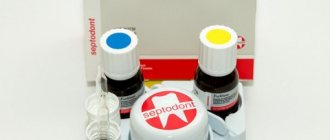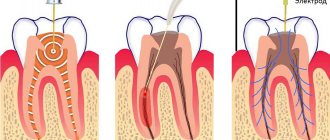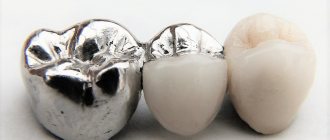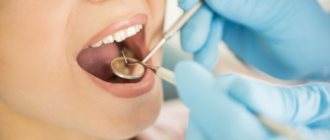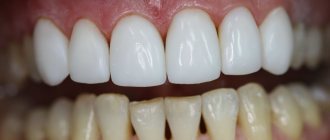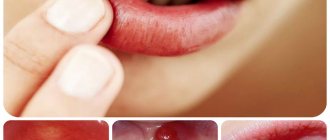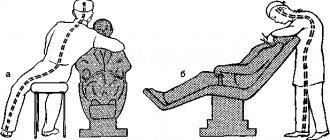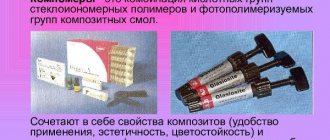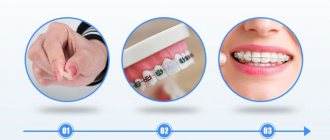Foredent (Foredent) - a material based on resorcinol-formalin resin, used for permanent filling of tooth root canals. Available in the form of powder and liquid, which when mixed form a special paste with a disinfecting effect, from which permanent fillings are made. Sealer Foredent is the simplest and most affordable product, used everywhere in most clinics in the CIS.
Instructions: Foredent
The most important substance of the drug, resorcinol-formaldehyde resin, is a toxic substance that causes negative consequences if inhaled or in contact with open skin and mucous membranes. For safety reasons, the tooth to be filled must be completely isolated from neighboring tissues. To achieve this, dentists use rubber dam substances.
Installed rubber dam on a tooth
Work with Foredent substance only with gloves and in a well-ventilated area. If the drug gets on the skin or mucous membranes, it is necessary to treat the area with water as soon as possible.
How to mix Foredent?
To prepare the filling paste, apply 1 drop of liquid from each bottle to a clean glass surface. The mixture of liquids is condensed with powder to a homogeneous mass. Grind with a metal spatula until the paste is creamy, smooth and has a uniform consistency.
The resulting mixture remains plastic for 24 hours.
An example of correct work with Foredent
Initial situation. The patient is 14 years old. Treatment with Foredent
Root canal filling can only be started with a rubber dam.
Permanent filling Estelite Sigma Quick
Result after treatment.
X-ray picture after root canal filling with Foredent
Key features of the material
The substance is produced by a Czech company – Spofa Dental. The product is fully certified and safe for use according to all European standards. The main components of the drug are resorcinol and formaldehyde. These components are included in a set consisting of 40 grams of powder mixture and two containers with liquids of 25 grams each.
The dental product Foredent is a material that has long proven itself to be simple and easy to use. A filling preparation created on the basis of resorcinol-formaldehyde resin has a huge number of advantages when working:
- easy to process;
- remains unchanged in volume;
- fits well into the canal;
- has a strong disinfectant effect;
- radiopaque;
- guarantees reliable tightness of the sealed canal.
The paste hardens in about an hour. The filling mixture becomes completely hard within a week.
The manufacturer of the drug recommends storing Foredent in a cool, dark place at temperatures from +5 to +25C.
Where is polypropylene used?
Basic properties of building materials: mechanical, physical, chemical and technological.
classification of building materials and innovations in modern construction Polymer synthetic material can replace expensive analogues, allowing to reduce labor and material costs. Therefore, it is effectively used in a variety of fields.
Food industry
In the manufacture of plastic bottles, dishes, lids, cling film, packaging containers (the polymer ensures low material consumption). Despite the fact that the products have minimal thickness, their shape remains durable.
Artificial threads
Strong, heat-resistant, elastic fibers are obtained from synthetic plastic (more products are obtained from 1 kg of the substance than from the same amount of another polymer). The disadvantage of special threads is their vulnerability to ultraviolet radiation. The introduction of modified additives makes it possible to increase its chemical properties. Ropes, ropes, twines are effectively used in the field of shipbuilding.
Machinery and instrument making
The high wear resistance of the material determines its widespread use in production:
- parts for fans, cooling systems, vacuum cleaners, refrigerators;
- fuse blocks;
- shock absorbers;
- filters;
- battery tanks;
- seals for body parts;
- bumpers;
- dashboard;
- floor mats, etc.
Pharmacology
Polypropylene is successfully used in medicine - it is used to make inhalers, syringes and other medical supplies that can be steam treated (sterilized):
- test tubes;
- sample and IV bottles;
- baths;
- Petri dishes;
- containers for tablets;
- elements of diagnostic devices.
Electronics
Thermoplastic material ensures high quality:
- insulating shells;
- coils;
- telephone sets;
- housings for televisions and radios;
- communication wires.
Package
Thermoplastic polymer films are a popular packaging material with high performance properties. Flexible, transparent, easily weldable and non-toxic, the films are sterilization and chemical resistant, making their value in the medical and food industries undeniable.
They are used as bags for packaging fruits, berries, vegetables, confectionery and bakery products, bulk products for transportation and storage. PP packaging is convenient, roomy, and lightweight.
An innovation in the packaging industry is specially oriented films that have increased transparency, rigidity, strength and moisture resistance. Glossy products successfully replace label paper.
Use of polypropylene in everyday life
- plastic furniture;
- carpets;
- dishes;
- oilcloth;
- toys;
- buckets, basins, flower pots;
- soap dishes;
- vegetable boxes;
- flasks;
- bags, garbage bags;
- disposable diapers and other household items.
Modern manufacturers choose PP as an alternative to other materials due to:
- environmental friendliness;
- cost;
- ease of disposal and recycling.
It is believed that the scientific potential of the thermoplastic synthetic substance has not been fully realized.
Reviews
The root canal sealing procedure differs from a simple tooth filling. There are special requirements for materials for this process.
Materials are constantly being improved or replaced with new ones. Despite the variety, dentists still use formalin-based products in their work, one of which is Forfenan.
You can share your opinion regarding the effectiveness and feasibility of using this material for endodontic treatment by leaving a comment on this article.
If you find an error, please select a piece of text and press Ctrl+Enter.
Tags filling fillings
Did you like the article? stay tuned
Previous article
How to choose a good dentist so you don’t regret it later?
Next article
Interesting technology for gentle teeth whitening Luma Cool
Phenoplast
Properties and applications of cellular polypropylene
Phenolic plastics are used for the manufacture of various products by direct compression using heat. Some phenolic plastics are used for injection molding and extrusion.
Phenoplastics are divided into grades depending on their constituent components.
Phenolic plastics are a pressed material mainly made from phenol-formaldehyde resin with fillers.
Phenoplastics are divided into powder, crumb-like, fibrous and layered.
Phenolic plastics are a pressed material mainly made from phenol-formaldehyde resin with fillers. Phenoplastics are divided into powder, crumb-like, fibrous and layered.
Phenoplastics - polymers based on phenol-formaldehyde resins - are produced with organic or mineral fillers.
Phenolic plastics are produced industrially in the form of press powders, fibrous and layered materials.
Phenolic plastics have satisfactory dielectric properties (especially if the filler is quartz flour), successfully combined with high heat resistance.
Phenolic plastics (based on phenol or cresol) are produced in the form of corrugated sheets, plates, etc., do not get wet, do not corrode, and are cheaper than metal.
Phenoplastics reinforced with organic and inorganic fibers are successfully used in rocket science as materials with ablative properties.
Phenolic and amino plastics are injection molded on presses, like thermoplastics.
Phenoplastics with organic fillers are allowed for long-term operation 100 - PO 1 C, for a short time ... Zi C with the same additional shrinkage as indicated above. Phenolic plastics, manufactured in accordance with GOST 5689 - 60 of seven types, are widely used as electrical insulating and structural insulating plastics in instrumentation and apparatus manufacturing. Each type is divided into groups. Type O for general technical purposes contains wood flour as a filler; group 04 - impact-resistant, has a rubber-modified resin as a binder. Type E - electrical insulating is made with mineral fillers, both with modified resol resin (EZ group) and with unmodified resins. The HF high-frequency type is manufactured, like the E type with mineral fillers, on a modified resin. Type Bx moisture-chemical-resistant is manufactured with different fillers and resins. Type VL - impact-resistant, coarse-fiber, made with organic long-fiber filler and asbestos fiber. Type Zh - heat-resistant, used for electrical installation parts with mineral filler.
Phenolics with organic fillers allow long-term operation at 100 - 110 C, short-term operation at 115 - 135 C with the same additional shrinkage as indicated above. Phenolic plastics, manufactured in accordance with GOST 5689 - 66 of seven types, are widely used as electrical insulating and structural insulating plastics in devices and apparatus manufacturing. Each type is divided into groups. Type O - general purpose, made from novolac resin and contains wood flour as a filler; group 04 - impact-resistant, has a rubber-modified resin as a binder. Type Sp is a special ammonia-free type, made from resole resin with wood flour with and without certain electrical insulating properties. Type E - electrically insulating, made from resole resins with both wood flour and the addition of a mineral filler. HF type - high frequency, made of resol and novolac modified resin with mineral fillers. Type Bx - moisture-chemical resistant, made from novolac resins with different fillers. Type VL - impact-resistant, coarse-fiber, made from resol resins with organic long-fiber filler and asbestos fiber. Type Zh - heat-resistant, made of novolac resins with mineral and mixed fillers.
Phenolics are very common thermoset plastics made from phenolic resins, often called bakelites. Phenol is isolated from coal tar and is also obtained synthetically from benzene.
Phenoplasts and aminoplasts with organic fillers are unstable to the action of alkalis, and getinax is much less resistant than textolite. At the same time, phenoplasts resist the action of weak hydrochloric and sulfuric acids much better. Phenolic and amino plastics are highly resistant to gasoline, transformer oil and sea water.
Smart drug Forfenan for endodontic dentistry
1243
During endodontic treatment, the dentist faces several tasks - suppression of pathogenic microflora in the tooth canal, reliable sealing of the cavity, ensuring the longest possible antimicrobial effect in order to prevent re-infection of the tooth.
The pharmacological industry produces a variety of therapeutic and filling materials that make it possible to successfully cope with this task.
Purpose and composition
Forfenan is a product of the well-known manufacturer of dental materials Septodont (France), intended for disinfection and obturation of the root canals of permanent teeth, including the most complex and difficult to pass areas.
In addition to filling the canals of permanent teeth, forfenan can be used to treat primary teeth using the method of mortal amputation (mummification of the root pulp).
The drug is not recommended for use on front teeth due to the fact that it can change the color of the crown of a pulpless tooth .
The composition is three-component. Includes a plastic jar with 20 g of powder and two bottles of liquid (antiseptic and hardener) of 10 ml each.
Powder composition:
- enoxolone, 1.0 g – an antiviral drug that has anti-inflammatory and analgesic effects, promotes tissue regeneration;
- barium sulfate (BaSO4), 49.0 g – radiopaque component;
- dexamethasone , 0.20 g – glucocorticosteroid with anti-inflammatory activity (not present in all kits);
- filler – up to 100.00 g.
Composition of the antiseptic liquid:
- formalin , 80.00 g - 35% formaldehyde solution, which has a disinfectant and deodorizing effect;
- Filler up to 100.00 g.
Composition of the hardener liquid:
- resorcinol (resorcinol) (C6H4(OH)2), 25.0 g – meta-dioxybenzene, which has antimicrobial, dermatoprotective and antiseborrheic properties;
- hydrochloric acid (HCl), 13.00 g – etching and bleaching component;
- filler – up to 100.00 g.
Characteristics
When mixing the components of forphenan, a plastic mass is formed that hardens within 24 hours.
During polymerization, the material heats up slightly, releasing formaldehyde gas, which penetrates the dentinal tubules, binds to albumin, and has a long-term antiseptic effect on tooth tissue.
By changing the standard (1:1) ratio of antiseptic and polymerizing liquid, it is possible to change the plasticity and disinfecting activity of forphenan.
Main properties of the material:
- effective disinfection of dental tissues;
- reliable sealing of tooth canals;
- maintaining the antiseptic effect for a long time, thanks to the deep penetration of formaldehyde into the dentinal tubules.
Advantages
Forfenan has a number of advantages that make it popular among dentists:
- ease of use (good plasticity, sufficient for leisurely manipulation of the composition during working hours);
- rapid antiseptic treatment of dental canals, thanks to the high disinfecting activity of formalin and other components;
- strength and reliability of filling;
- the ability to control the consistency and antiseptic activity of the drug by changing the ratio of disinfectant and polymerization liquid;
- radiopacity (allows for high-quality radiographic diagnostics);
- no shrinkage;
- the ability to be used for pulp mummification in temporary teeth and difficult-to-pass canals of permanent teeth.
Kneading technique
The technique of preparing the mixture before the filling process consists of three stages:
- Pour the required amount of powder onto the poly-panel using the dispensing spoon included in the kit.
- Add hardener liquid and antiseptic liquid to the powder using droppers at the rate of 1 drop per 1 dispensing spoon.
- To stir thoroughly.
Note. If it is necessary to obtain a less thick consistency, 2 drops of antiseptic are added to 1 drop of hardener.
Application Guide
Filling dental canals with Forfenan is carried out using standard technology:
- Anesthesia.
- Isolation of tooth with rubber dam.
- Treatment of canals with burs.
- Rinsing and disinfection of canals with antiseptics (sodium hypochlorite, hydrogen peroxide).
- Drying the cavity with paper points.
- Mixing Forphenan.
- Canal filling.
The paste is applied in small portions. The simultaneous use of gutta-percha pins is possible, especially in cases where the possibility of re-treatment cannot be excluded.
Pulpotomy with mummification of the pulp of a baby tooth
- Anesthesia.
- Isolation of tooth with rubber dam.
- Preparation of a cavity affected by caries.
- Opening the tooth with a high-speed, water-cooled bur.
- Removal of coronal pulp using an excavator or bur.
- Rinse the cavity with distilled water, dry with cotton balls.
- Control and eliminate bleeding if necessary.
- Preparation (mixing) of forphenan.
- Introducing material into the mouth of the canal, covering the pulp horn.
- Permanent tooth filling with Forfenan or other filling paste.
The use of Forfenan for devital pulp amputation is most appropriate in school-age children with pronounced resorption of the roots of primary teeth and replacement of the root pulp with granulation tissue.
Recommendations and precautions
Recommendations:
- before treatment, it is necessary to clarify whether the patient is allergic to the components of forfenan;
- It is undesirable to use forfenan for obturation of the anterior teeth due to the possibility of changing their color;
- To protect the tissues surrounding the tooth from the negative effects of formalin, it is recommended to use rubber dam.
Precautionary measures
The formalin (formaldehyde) contained in the disinfecting liquid is toxic, an irritant (irritates and burns the mucous membranes and respiratory tract) and a carcinogen.
Particularly hazardous if accidentally swallowed. It is also necessary to prevent the release of formaldehyde into the environment.
The polymerization liquid contains resorcinol, dust and vapors of which irritate the respiratory tract, mucous membranes, skin, and cause coughing.
The danger of forphenan components should not be exaggerated due to the small amount of toxic substances, however, working with it requires caution.
- It is necessary to use PPE - gloves, protective clothing, mask and goggles.
- The drug should not be allowed to enter the environment.
- You need to work with Forfenan in a ventilated area.
In case of contact with unprotected surfaces (mucous membranes, skin, eyes), rinse the area with plenty of water. If you feel unwell, you should immediately seek professional medical help.
Release form, storage and price
The drug is sold as a kit, which includes:
- disinfectant liquid in a bottle (10 ml);
- liquid hardener in a bottle (10 ml);
- powder in a jar (20 g);
- dispensing spoon;
- two dropper pipettes for measuring liquid.
Storage conditions:
- inaccessibility for children;
- temperature +5-+25 °C;
- protection from direct sunlight;
- tight closure of containers.
Shelf life – 2 years, after opening the packages – 2 months.
The price of the set, depending on the region, varies from 5,000 rubles. and higher.
Analogs
In addition to the drug described, dentists use other similar compounds:
- Viedent .
The basis of the material is epoxy amino polymer. Manufacturer: Russian company VladMiVa. The two-component composition is available in 2 types: paste + paste (4 ml of each component) and powder (20 mg) + liquid (10 ml). Designed for obturation of canals with apical periodontitis and pulpitis using intracanal pins, including gutta-percha. Can be used with implants. The cost of both forms of release is 250-290 rubles. - Foredent .
A filling material with the same purpose as forphenan. Manufacturer: Czech company Spofa Dental. The basis of the drug is formaldehyde resin. The product is three-component – powder 40 g and liquid in 2 bottles of 25 ml. When they are mixed, a plastic mass is formed that hardens within an hour. The material gains final strength after 7 days. Cost – 370-420 rubles. - Resident .
Filling preparation from the Russian company VladMiVa. The basis of the product is resorcinol-formaldehyde resin. The set consists of 3 components: antiseptic liquid with formaldehyde (5 ml), hardener liquid with resorcinol and catalyst (5 ml), powder with radiopaque filler (10 g). Designed for disinfection and filling of complex canals and cavities with incompletely removed pulp. After mixing the components, the working time is 30 minutes. Complete hardening within a day. Cost – 150 rubles. - Resorcinol. Resorcinol-formaldehyde composition used for filling root canals.
Produced by the domestic company Omega Dent. The three-component composition includes: powder 25 g (barium sulfate, zinc oxide), antiseptic liquid 10 ml (formaldehyde), hardener liquid 10 ml (HCl, filler). Price – 500-700 rub.
Reviews
Despite certain toxic properties, resorcinol-formaldehyde pastes are still widely used for filling root canals.
Among the main advantages are high disinfecting properties that prevent relapses of infection of the treated tooth.
Processing into products
Izolon PPE: properties, advantages and scope of application of the material
The production of products from thermoset plastics is mainly carried out using injection molding or direct pressing methods. A more modern method is injection molding, which differs from traditional thermoplastic molding by the presence of a heated mold, not a cooled one, operating in the range of 160-210 degrees C.
With all these methods, a chemical reaction of cross-linking macromolecules takes place in the polymer, called curing. It usually takes minutes or even hours to complete the chemical curing interaction of the molecules. The technological process is complicated by the risk of early curing of the thermosetting resin, so the temperature regime for pressing and especially casting must be maintained accurately. In addition, precise dosing of the polymer mixture and its rapid injection into the mold is necessary due to the very short time possible for thermosets to be in a viscous-flowing (molten) state.
Products made from thermoset polymers after molding are suitable for post-processing by mechanical methods, as well as for joining with other products or materials using adhesives. In the case of a low degree of cross-linking, it is also possible to weld such products chemically.
Forfenan in dentistry for reliable and comfortable root canal treatment
1076
During endodontic treatment, the dentist faces several tasks - suppression of pathogenic microflora in the tooth canal, reliable sealing of the cavity, ensuring the longest possible antimicrobial effect in order to prevent re-infection of the tooth.
The pharmacological industry produces a variety of therapeutic and filling materials that make it possible to successfully cope with this task.
Material properties
If you mix the powder and both solutions that are included in the kit, it becomes possible for the radiopaque paste to harden within 24 hours. The basis of the resulting material is antiseptic paste and resin.
During polymerization, the material heats up and releases a certain amount of formaldehyde gas, which penetrates into the dentinal tubules. Formaldehyde gas converts the albumins present here into antiseptic mixtures.
As a result, Forfenan makes it possible to implement three actions at once during one procedure:
- accelerated antiseptic treatment of dentinal canals;
- introduction of long-term antiseptic material;
- durable filling of root canals.
Such a filling also has other characteristics: the material closely fills the canal, it is radiopaque, does not allow shrinkage, and there is a risk of staining the tooth crown.
In liquid form, Forphenan is produced as two separate solutions and this makes it possible to vary the degree of exposure and its duration in accordance with the amount of each solution used. If the amount of medicinal solution is increased, the process of releasing the gaseous antiseptic will be more intense. This promotes deeper sterilization.
This product, like phenoplasts, should not be used for filling anterior teeth due to the coloring effect. Neutralizing such a defect will be quite problematic (masking with lumineers or veneers). In general, Forfenan is considered a useful adjunct for all types of routine root canal fillings.
Application Guide
The treatment process for sealing root canals with Forfenan is carried out in the following order:
- The dentist examines the oral cavity and makes a conclusion about the condition of the problem tooth. If necessary, the patient is sent for an x-ray to determine the number, location and condition of the root canals.
- Examination of an x-ray.
- Conducting topical anesthesia. Before applying a local anesthetic, the mucous membrane is dried. As soon as the anesthetic has shown its full effect, it is washed off with a stream of water.
- Injection of anesthetic. Transcortical anesthesia is usually performed, during which the lips, palate and tongue do not become numb, but the sensitivity of the area of 4 teeth is lost (2 elements before and 2 elements after the injection site of the anesthetic).
- Full access to the canals is created for their treatment. Burs are used to open the pulp chamber or a special cutter is used to prevent overheating of the interroot zone.
- A rubber dam (latex curtain) is applied.
- The pulp chamber is opened. Infected remains are removed from it.
- Instrumental and then medicinal treatment of the canals is carried out.
- Drying.
- Filling the canals along their entire length with Forfenan paste. The material is introduced in portions using a root needle or channel filler.
At the end of the process, an x-ray is taken. The procedure is mandatory during endodontic treatment and is necessary to assess the quality of canal sealing.
Basic properties and types of material
The use of phenolics is based on a number of remarkable properties characteristic of this material:
- Low specific gravity - from 1.0 to 1.8 g/cm3. Approximately, we can talk about a 5-fold advantage compared to ferrous and non-ferrous metals in the overall assessment.
- High anti-corrosion resistance. Phenolic plastic is not only not subject to the destructive effects of oxygen, but also successfully resists other aggressive chemical environments. The material exhibits weak resistance only when interacting with concentrated acids and alkalis.
- High mechanical strength, which can exceed the strength of cast iron. Finished parts work successfully not only in belt drives, but also in sliding bearings based on this polymer. The anti-friction resistance of the material also manifests itself here, when additional lubrication is not required for work where friction is present.
- Plastic. This property can be achieved under certain conditions, which makes it possible to obtain not only durable products, but also gives them the necessary flexibility.
- Non-conductivity of electric current. This property allows phenolic plastic to be used in electrical engineering as a dielectric.
- Light transmission. Along with daylight, phenolic plastic transmits rays in the ultraviolet range, which is an important advantage compared to silicate glass.
- Low thermal conductivity. With an average value of 0.3, the material is successfully used as thermal insulation.
- Possibility of coloring. This ability allows you to successfully replace expensive decorative elements made from natural materials.
The ability to endow manufactured parts with certain properties makes phenolic a truly unique material, and the scope of its application is constantly increasing.
When dividing phenol plastic along the main two directions, the resol group and novolac resins can be distinguished. Resol material is obtained with an excess of aldehydes and an alkaline catalyst. In this case, the use of hardeners is not required.
Novolac resins require the use of hardeners and are produced by polycondensation with an excess of phenol in an acid catalyst.
The entire line of produced phenolic plastics is quite wide, which is explained by the possibility of using various fillers in the production of the final material. The following main types of products can be named:
- press powders;
- reinforced phenolics;
- crumb-like press materials;
- laminated plastics;
- textolites;
- wood plastics;
- getinaks.
One of the main groups of phenolic plastics are reinforced phenolic plastics. The properties of the part are enhanced by including components such as carbon fibers, wood veneer, woven or other fibrous materials, and even paper. Depending on the endowed properties, the final material is obtained, which is subject to finishing and can be used in a wide variety of areas.
Reinforced phenolic plastic is produced in the form of a matted fibrous or granular final product. More convenient to process is granular material, which allows you to make pressed slabs from granules with a length of 5 to 30 mm, with further production of final parts. Using this technology, textolite, fiberglass, and getinax are produced.
All extruded materials have fairly stable mechanical, primarily strength, properties, which allows them to be successfully used in the field of mechanical engineering. Among other processing methods, casting, spraying or winding of the material are also used. Various chemical compounds are used for hardening.
Countries that are leaders in industrial production have their own patented developments, where phenolic plastics have certain unique properties:
- duroton – Germany;
- richelite - Japan;
- tourneron – France;
- textolite - USA.
Such a variety of resulting types of materials based on phenolics allows us to constantly expand the scope of application, and the annual production volume in the world is already in the tens of millions of tons.
Filling material Foredent - modern aspects of use
The manufacturer of the drug is a Czech company – Spofa Dental. The drug includes two components that are mixed during the dentist’s work: powder and liquid. The mixture is resorcinol - a formaldehyde homogeneous paste. The main active ingredients of the drug are resorcinol and formaldehyde.
The set consists of a glass container containing 40 g. powder and two bottles of liquid (25 g each). The drug is convenient and very easy to use.
Foredent is an endodontic material. The basis of the composition is resorcinol-formaldehyde paste, thanks to which the filling material is characterized by the following properties:
- it is easy to process and insert into the canals;
- has a strong bactericidal and bacteriostatic effect;
- long-lasting disinfecting effect (disinfects dentin even in difficult-to-pass parts of the canals);
- retains its constant shape well after hardening;
- has high radiopacity;
- ensures the tightness of the seal (tightly seals the sealed channel).
The filling mixture hardens in about an hour. Final hardening is completed after 7 days.
Purposes of use
Foredent is well suited for filling root canals after pulp removal. Intended for use in periodontal treatment and for the manufacture of fillings relating to the apical foramen (foramen apicale).
Filling material can also be used for additional surgical procedures (alveolotomy, root tip resection, periapical curettage).
This is important - restrictions and contraindications
The use of Foredent is undesirable when filling the frontal areas of teeth. Over time, the material changes color, the filling becomes pink-brown, which does not look very aesthetically pleasing. Correcting such a cosmetic defect is not easy; camouflage will be required.
The basis of the drug is made up of potent substances that are toxic. They can have a negative effect if they get on dental tissue. Formaldehyde can permeate tissues and escape beyond the boundaries of the tooth. If the marginal seal of the filling is broken, the active substance enters the oral cavity and respiratory tract.
When working with paste, it is necessary to ensure good insulation of the damaged tooth and surrounding tissues; for this, insulating materials (cofferdam, rubber dam) are used.
The components of the product can cause allergic reactions, so you need to take into account the possibility that the patient is allergic to the components of the drug. The body's response to the filling material may occur when the paste is moved beyond the apex.
Important! Filling the cavity with this material is carried out up to the apex; above that is not recommended.
Composition and release form
Antiseptic (disinfectant) agent, store in a place protected from light
The active component of Resorcinol is meta-dioxybenzene. The drug is intended for external use and is available in the following forms:
- Powder, dosage - 1 g.
- An alcoholic or aqueous solution of Resorcinol, which may have a concentration of the main component of 1-5%.
- Ointment - 5, 10 or 20% concentration of the main active ingredient.
Indications for use
The use of Resorcinol is indicated for a number of viral, infectious and inflammatory skin diseases. We are talking about the following pathologies:
- dermatitis;
- eczema;
- sycosis;
- seborrhea;
- mycosis;
- fungal infections;
- skin itching.
Resorcinol can be used in combination with hormones and antibiotics in the treatment of alopecia or acne.
Side effects
Just like phenol, resorcinol formaldehyde, if used incorrectly, can cause a number of undesirable reactions from the body. The most common effects that occur are:
- nausea;
- vomit;
- severe headaches;
- dizziness;
- increased sweating;
- cyanosis;
- increased heart rate;
- spasms and cramps;
- loss of consciousness.
In rare cases, after taking Resorcinol formaldehyde, allergic reactions such as dermatitis, itching and redness of the skin, urticaria, bronchospasm and angioedema may develop.
Drug interactions
Before you start taking Resorcinol, you should carefully read the instructions for drug interactions with other drugs.
Formalin resorcinol is absolutely incompatible with the following drugs:
- Antipyrine.
- Camphor.
- Salicylic acid.
- Menthol.
- Phenyl salicylate phenol.
If we are talking about an alcohol solution or a powder form of the product, then it is incompatible with substances that have an alkaline reaction. In the form of an ointment, the product cannot be used together with yellow mercuric oxide, since the latter completely loses its effectiveness.
Possible analogues (substitutes)
Bactericidal adhesive plaster (from 2.00 rubles), Diamond green (from 2.45 rubles), Hydrogen peroxide (from 4.00 rubles), Boric acid (from 5.42 rubles), Iodine (from 5.90 rubles)... Show all analogues of the drug Resorcinol » Attention: the use of analogues should be agreed with the attending physician.
Active substance, group
Resorcinol, Antiseptic
How to use: dosage and course of treatment
Externally, 2-5% aqueous and alcohol solution of Resorcinol, 5-10-20% ointment.
pharmachologic effect
Antiseptic, has dermatoprotective and antiseborrheic effects.
special instructions
There are no special instructions for the use of Resorcinol.
Use during pregnancy and lactation
If you are breastfeeding, you should avoid using Resorcinol.
According to most experts, women should not use antiseptics during pregnancy or breastfeeding. This is due to the fact that the drug has toxic properties.
Its active substance in a certain amount can penetrate the human body and biological fluids.
As a result, the likelihood of negative effects of the medication on the fetus or newborn child increases.
Solution
Resorcinol solution must be applied externally to the affected areas. It is best to do this with a clean cotton swab. The dosage regimen of the drug is selected for each patient separately.
If a patient is diagnosed with red acne, he is prescribed skin treatment with a 1% alcohol-based solution. 1-2% product is suitable for the treatment of oily seborrhea, dermatitis and eczema.
Ointment
10-15% ointment is recommended to be applied in a thin layer to areas that are covered with acne and need exfoliation. If a person is sick with seborrheic eczema, then he should combine the drug with sulfur.
Methods for producing phenolic plastics and processing them into products
The filler for press powders, such as phenolic plastics, is most often wood flour, much less often fine-fibered asbestos. Mineral powder fillers used include fluorspar and dusted quartz.
Press materials such as phenolic plastics are produced using “dry” and “wet” methods. With “dry” methods, the resin is used in dry form, and with “wet” methods in the form of an alcohol varnish (varnish method) or a water emulsion (emulsion method).
Processing of phenolic plastics into products is carried out in various ways. The oldest and most common industrial method is direct pressing (also called hot or compression pressing) applicable to all types of press materials described.
The injection molding method, also called transfer or spritsguss, is used only for processing press powders when the product must include complex fittings.
The continuous extrusion method is used for the manufacture of various profile products from press powders (tubes, rods, corners).
Tooth extraction in children
Milk teeth are removed according to indications:
- Significant destruction by caries.
- Severe inflammation.
- Delayed resorption of the roots of primary teeth.
- The beginning of the growth of a permanent tooth when the milk tooth has not fallen out.
- Mechanical injuries, chips.
- Complicated diseases (phlegmon, periodontitis, fistulas, cysts).
- Severe pain in the area of a mobile baby tooth.
Application
Parts made using phenol-formaldehyde polymers
Used to produce plastics (hardened resins are called resites
, cured in the presence of petroleum sulfonic acids -
carbolites
, lactic acid -
neoleukorites
), synthetic adhesives, varnishes, sealants, switches, brake linings, bearings, also widely used in the manufacture of billiard balls. The housings of Soviet multimeters of various models were made from carbolite.
Used as a binding component in the production of filled press compositions with various fillers (cellulose, fiberglass, wood flour), wood-fiber and particle boards, impregnating and casting compositions (for plywood, woven and fiber-filled materials).
For a number of properties, plastics based on phenol-formaldehyde resins still remain an unsurpassed material. They are used to produce:
- Parts for a wide range of mechanical engineering products, steps for escalators in the subway, handles for tools, etc.
- Abrasive tools, brake pads for subway cars.
- Electrical products - plugs, sockets, switches, electric meters, electric irons, electric motor housings, relays and magnetic starters, terminal boxes, etc.
- Cases of various devices - telephones, radios, cameras; parts of electronic equipment elements - radio tubes, cathode ray tubes, capacitors, etc.
- Details of weapons and military equipment.
- Elements of kitchen utensils: handles for knives, frying pans, pots and kettles, gas stoves.
- Plywood and particle boards (binding material). Furniture parts and furniture fittings.
- Getinax is a material for the manufacture of printed circuit boards.
- Textolite is a material for the manufacture of printed circuit boards and a structural material.
- Checkers, chess, dominoes and other inexpensive elements of board games.
- Souvenirs, stationery, jewelry, watches.
- Glues and varnishes, for example, BF glue.
- Ablative protection of descending spacecraft.
Preventive measures
You should take your child to the dentist for a preventive examination regularly. This will help reduce the risk of developing caries. We also recommend following preventive measures:
- Reduce the amount of sugar in your child's diet.
- Balance the diet so that the baby receives all the necessary micro- and macroelements and vitamins from food.
- Introduce solid foods into your diet.
It is imperative to teach your child how to use a toothbrush and brush his teeth correctly. Choose a special baby brush and toothpaste for your baby. At first, parents should monitor hygiene procedures, the regularity and correctness of their implementation. From the age of 5, a child can be taught to use dental floss and mouthwash.
Opinion about the drug
The use of resorcinol-formaldehyde substances in modern practice raises much debate about the safety and appropriateness of their use. Some dentists call this mixture very dangerous for the human body. The main materials used are highly toxic.
Filling pastes have mutagenic properties and have a teratogenic effect. Formaldehyde has the ability to spread throughout the body and gradually poison it. Teeth filled with resorcinol-formaldehyde resins cannot support dentures.
For a very long time, dental canal fillings have been performed using resorcinol and formaldehyde. Over many years, the manufacturer has learned to make the safest drug, Foredent, that meets all standards.
It is one of the most common dental materials in the world. All components and quality of the paste meet all European standards.
Foredent is certified and recognized by leading dental clinics in the world.
- https://zubodont.ru/foredent/
- https://dentazone.ru/preparaty-oborudovanie/materialy/foredent.html
- https://clubzub.ru/plombirovochnyj-material-foredent-sovremennye-aspekty-ispolzovaniya.html
- https://www.vash-dentist.ru/lechenie/zubyi/plombyi/pastyi-forfenan-v-stomatologii.html
- https://zubodont.ru/non-arsenik/
- https://zubovv.ru/lechenie/zubyi/plombyi/forfenan-v-stomatologii.html
- https://zubodont.ru/forfenan-v-stomatologii/
- https://dentazone.ru/preparaty-oborudovanie/materialy/forfenan.html
Ekaterina Belikova
Dentist-therapist. Periodontist. Doctor of the highest category. High class specialist. Specializes in the treatment of carious and non-carious dental lesions.
Purposes of use
Foredent is well suited for filling root canals after pulp removal. Intended for use in periodontal treatment and for the manufacture of fillings relating to the apical foramen (foramen apicale).
Filling material can also be used for additional surgical procedures (alveolotomy, root tip resection, periapical curettage).
Application of Foredent in dentistry
After depulpation, Foredent is most often used as a filler for the root canals of the tooth. It is also used in the treatment of periodontal disease with the installation of a filling in contact with the apical foramen. Material based on resorcinol-formaldehyde is often used for indirect third-party interventions: periapical curettage, dissection of the wall of the tooth alveolus, resection of root tips.
Environmental aspects
Toxic materials are used in production. Both phenol and formaldehyde are poisonous and flammable. Formaldehyde has a carcinogenic and also depressant effect on the nervous system.
Phenol-formaldehyde resins can be harmful to the skin and can cause dermatitis and eczema. Uncured phenol-formaldehyde resin can contain up to 11% free phenol.
When phenol-formaldehyde resins are cured in plastic (phenoplasts), cross-linking of oligomeric fragments of the resin occurs with the participation of the free phenol contained in it, while the content of phenol incorporated in the phenol is reduced to trace amounts; sanitary standards of the Russian Federation regulate the permissible amounts of migration of phenol and formaldehyde for products made of phenolic plastics; in particular, for products in contact with food for phenol - 0.05 mg/l, for formaldehyde - 0.1 mg/l.
A big problem is the difficulty of recycling or reusing phenol-formaldehyde products.
Characteristics
Forfenan has established itself as a convenient and easy-to-use material that allows three actions to be carried out simultaneously in just one procedure:
- Carry out accelerated antiseptic treatment.
- Introduce a long-acting antiseptic.
- Seal the channels hermetically.
When mixing the components included in the Forfenan kit, the resulting paste hardens within 24 hours. The basis of the mass is formed by an antiseptic mixture and red resin.
During polymerization, the temperature of the material rises, and a certain volume of gaseous formaldehyde is released from it, penetrating into the dentinal canals . This substance converts the albumins present in the components into insoluble antiseptic mixtures.
Herculite filling material and instructions for its use.
Let us discuss here the features of the dental material Ionosit.
At this address https://www.vash-dentist.ru/lechenie/zubyi/plombyi/pastyi-kalasepta-v-stomatologii.html we will look at the properties of Kalasept paste.
Composition and production of phenolic plastic
Compression of phenolic plastics is considered the main production process. But according to its type, this phenol plastic can have different properties. Differences in the characteristics of the finished material are based on the use of different fillers. According to the type of filler, phenolics can be of two types:
- • dispersed-filled
- • reinforced.
The fillers of this material are press powders. These powders have different structures. The FP also includes:
- • phenol-formaldehyde resins,
- • silicon organic compounds
- • plasticizers,
- • lubricants in the form of stearin or oleic acid,
- • dyes.
The production of phenolic plastics is based on the process of rejecting all of the above components. The hardening process takes place at high temperatures. Phenolic plastics are processed in two ways - casting and pressing.
Restrictions and contraindications
Foredent tends to change color over time, so its use on the front teeth is undesirable. Pink-brown areas on the front incisors look extremely unsightly. Such a defect can only be eliminated using camouflage agents such as veneers and lumineers.
Resorcinol-formaldehyde material must be used extremely carefully, taking into account all the nuances. When toxic components get on various tissues, they have a harmful effect on them. Formaldehyde, which is part of Foredent, tends to permeate tissues and penetrate beyond the boundaries of the tooth, so it is necessary to carry out isolation very carefully.
This is interesting: What is bruxism, what are the consequences and treatment
Potent substances that enter the oral cavity and respiratory tract lead to negative consequences, so strict adherence to the marginal seal of the filling is required.
Substances in Foredent may be allergens, so it is necessary to clarify whether the patient is allergic to the components of the drug.
A person may experience a reaction to toxic substances if the paste gets beyond the apex.
The cavity is filled with Foredent only up to the apex.
Physical characteristics and properties of DBP
DBP plasticizer has an oily and liquid consistency. The color of this substance has a slight yellow tint. It is almost impossible to dissolve with water, but it dissolves perfectly with ethanol, gasoline, various alcohols or acetone.
Organic solvents also provide a good environment for complete dissolution. The boiling point of DBP is 340 °C. This substance does not have strong viscosity.
Plasticizers by their nature:
- • compatible with polymers,
- • have a low degree of volatility,
- • do not have a characteristic odor,
- • chemically inert substances,
- • non-toxic.
The entire group of plasticizers around the world is divided into:
- • butyl alcohol phthalates, DBP,
- • octyl alcohol phthalates, DOP,
- • alcohol phthalates C9 and C10 and other ethers.
Analogs
Dentists also use analogues of Forfenan in their work, which are not inferior in characteristics and properties to the material in question.
Resorcinol
White with a grayish or light yellow tint, crystalline powder. It has a specific faint odor and quickly dissolves in alcohol or water.
In light and air it changes its color to pink. It is a derivative of phenol, but is slightly inferior in antimicrobial activity.
Phenol is less toxic and less irritating to mucous membranes and tissues. It is characterized by keratoplastic (at low concentrations), keratolytic and cauterizing effects (at high concentrations).
In dentistry it is still applicable in the case of:
- treatment and sealing of root canals for complicated caries;
- cauterization of keratinized areas of the mucous membrane;
- treatment of periodontal disease.
The demand for the material is explained by several facts:
- ease of operation;
- quickly achieving the required result;
- low cost.
Important! Over time, a resorcinol-based filling turns the treated dental element pink.
Rezident
The material is used for antiseptic treatment and filling of root canals (including difficult to pass) with partial pulp expiration.
Set contains:
- medicinal liquid containing formaldehyde;
- hardening liquid;
- powder based on resorcinol and radiopaque filler.
Additionally, it exhibits an anti-inflammatory effect.
Foredent
It is used for closing canals after depulpation, in periodontal treatment, as well as during third-party interventions (for example, during resection, dissection of alveolar walls, periapical curettage). Has a pronounced disinfectant effect.
The material is based on resorcinol-formaldehyde, known for its toxicity and negative effects. Therefore, when working with it, doctors strictly adhere to the dosage and observe safety precautions.
Typical representatives
If among thermoplastic polymers you can find such well-known materials as polyethylene, polypropylene, PVC, polystyrene, PET and so on, then thermosets are now less known. This fact is especially interesting in view of the fact that in the mid-20th century, thermoset polymers were used more widely than thermoplastic plastics. Even in the 1980s and 1990s, plastics processing departments spent more time on compositions based on curable resins, their modifications and the production of products from them. This fact is due to the fact that, although the most important thermoplastics were obtained a very long time ago (many are more than 100 years old), brands with valuable, especially strength properties, did not exist for a long time.
The most widely used in modern industry are thermosets based on polyester, phenol-formaldehyde, epoxy, aminoaldehyde and urea resins.
Fig.1. Epoxy adhesives are one of the main applications of thermosetting resins
Thermoset compositions generally consist of a binder and fillers. The binder is directly a thermosetting polymer (resin), examples of such polymers are phenol-formaldehyde, urea-formaldehyde and melamine-formaldehyde, epoxy, polyester, etc. The fillers used for thermosetting polymers are generally the same as for thermoplastics: chalk, talc, wood flour, fiberglass, but woven and fibrous materials such as cotton and other fabrics, cellulose, and long fibers from various materials are more often used.
When to see a pediatric dentist
You should visit the pediatric dentist regularly for preventive examinations.
You should immediately make an appointment with your child if you notice any of the following symptoms:
- A sharp rise in temperature for no apparent reason.
- Redness and swelling of the gums.
- A cheesy coating on the gums and oral mucosa.
- Increased tooth sensitivity.
- Discoloration of tooth enamel (yellowing, stains).
- Bad breath.
